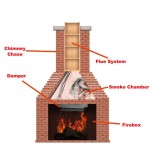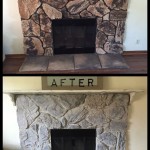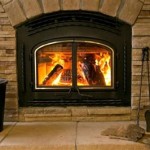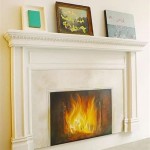Building A Mantel On A Brick Fireplace: A Comprehensive Guide
A brick fireplace serves as a focal point in many homes, offering both aesthetic appeal and functional warmth. Enhancing its presence with a well-constructed mantel can significantly elevate the overall design of a room. This article provides a comprehensive guide to building a mantel on a brick fireplace, encompassing planning, material selection, construction, and installation.
Planning and Design Considerations
Before commencing any physical construction, careful planning is essential. This stage involves assessing the existing fireplace structure, determining desired mantel dimensions, and selecting a design that complements the surrounding decor. The design should consider not only aesthetics but also functionality, ensuring the mantel is appropriately sized for displaying decorative items or supporting artwork.
The first step is to accurately measure the brick fireplace. Record the width and height of the firebox opening, as well as the overall dimensions of the brick facade. These measurements will inform the size and proportions of the mantel. Consider the vertical clearance between the top of the firebox opening and the bottom of the proposed mantel. Building codes and safety regulations typically dictate minimum clearances to prevent overheating and potential fire hazards. Consult local building codes for specific requirements in your area.
Selecting a design style is crucial. Common mantel styles include traditional, modern, rustic, and minimalist. Traditional mantels often feature ornate carvings, intricate moldings, and classic architectural details. Modern mantels tend to be sleek and minimalist, with clean lines and simple geometric shapes. Rustic mantels showcase natural materials, such as reclaimed wood or exposed brick, emphasizing a sense of warmth and authenticity. Minimalist mantels prioritize functionality and simplicity, often consisting of a single shelf or a series of floating shelves.
Sketching the design is highly recommended. Using a pencil and paper or digital design software, create a visual representation of the proposed mantel. Include detailed dimensions, material specifications, and any decorative elements. This sketch will serve as a blueprint throughout the construction process, minimizing errors and ensuring a cohesive design.
Consider the weight of the mantel and how it will be supported. Brick is a durable material, but the manner in which the mantel is attached is critical. Options include using heavy-duty anchors that are embedded into the brick mortar joints or constructing a supporting frame behind the existing brick. The chosen method must be capable of supporting the mantel's weight and any additional weight placed upon it.
Material Selection and Preparation
The selection of appropriate materials is crucial for both the structural integrity and aesthetic appeal of the mantel. Common materials include wood, stone, and concrete, each offering distinct advantages and disadvantages. Wood is a popular choice due to its versatility, affordability, and ease of workability. Stone offers a more durable and luxurious appearance, while concrete provides a contemporary and industrial aesthetic.
When selecting wood, consider hardwoods such as oak, maple, or cherry for their durability and resistance to warping. Softwoods like pine or fir are more affordable but may require additional sealing and protection. Ensure the wood is properly seasoned and kiln-dried to minimize the risk of shrinkage or cracking. The selection of wood will also affect the staining or painting process. Some wood takes stain better than others. Always test the stain on a piece of scrap wood before applying to the entire mantel.
If opting for stone, consider granite, marble, or limestone. These materials are highly durable and resistant to heat, making them suitable for fireplace applications. Stone mantels are typically heavier than wood mantels, requiring robust support structures. Stone cutting and shaping require specialized tools and expertise, and it is recommended to consult with a professional stonemason for complex designs.
Concrete mantels are becoming increasingly popular due to their modern aesthetic and versatility. Concrete can be cast into various shapes and sizes, allowing for unique and customized designs. Concrete mantels can be pre-cast off-site or cast in place, depending on the design complexity and site constraints. Concrete requires sealing to protect it from staining and moisture damage. The selection of concrete as a building material will require special tools, such as a concrete mixer and vibration equipment.
Once the materials are selected, proper preparation is essential. For wood, this involves cutting the individual components to the specified dimensions using a saw. Ensure accurate measurements and clean cuts for a professional finish. Sand the wood surfaces to create a smooth and even surface for painting or staining. For stone or concrete, cutting and shaping may require specialized tools and expertise. Clean the brick fireplace surface thoroughly to remove any dust, dirt, or debris. This will ensure proper adhesion of the mantel to the brick facade.
Constructing and Installing the Mantel
The construction and installation of the mantel involve assembling the individual components and securely attaching the mantel to the brick fireplace. This stage requires precision, attention to detail, and adherence to safety guidelines. Prior to beginning the installation, it is imperative to ensure that all tools and materials are readily available.
If constructing a wood mantel, assemble the frame according to the design sketch. Use wood screws, nails, or wood glue to join the individual components. Ensure that the joints are strong and secure. Add any decorative moldings or trim to the mantel frame. Use a miter saw to create clean and precise angles for corner joints. Fill any nail holes or gaps with wood filler and sand smooth.
For stone or concrete mantels, the assembly process may vary depending on the design. Pre-cast mantels typically arrive as a single unit, while cast-in-place mantels require constructing a mold and pouring the concrete. Ensure the mold is properly reinforced and sealed to prevent leaks. Allow the concrete to cure completely before removing the mold. Once cured, smooth any imperfections with a grinder or sander.
To attach the mantel to the brick fireplace, use heavy-duty masonry anchors. These anchors are designed to securely hold the mantel in place without damaging the brick. Drill pilot holes into the brick mortar joints at the designated anchor points. Insert the masonry anchors into the pilot holes and tighten them securely. Ensure the anchors are flush with the brick surface. It is important to note that drilling into brick is different from drilling into wood or drywall. The proper drill bit must be used to avoid damaging the brick.
Apply a bead of construction adhesive to the back of the mantel where it will contact the brick fireplace. This adhesive will provide additional bonding strength and prevent the mantel from shifting. Carefully lift the mantel into position and align it with the pre-drilled anchor points. Press the mantel firmly against the brick fireplace to ensure good contact with the adhesive.
Attach the mantel to the masonry anchors using screws or bolts. Ensure the screws or bolts are long enough to penetrate the brick and provide a secure hold. Tighten the screws or bolts gradually, alternating between anchor points to distribute the pressure evenly. Verify that the mantel is level and plumb using a spirit level.
Once the mantel is securely attached, fill any gaps between the mantel and the brick fireplace with caulk or mortar. This will create a seamless and professional finish. Allow the caulk or mortar to dry completely before applying any paint or stain. Inspect the installation for any signs of weakness or instability. Adjust the anchors or add additional support if necessary.
Finishing and Detailing
The final stage involves finishing and detailing the mantel to enhance its aesthetic appeal and protect it from damage. This may include painting, staining, sealing, or applying decorative finishes. The specific finishing and detailing techniques will depend on the chosen materials and design style.
If painting a wood mantel, apply a primer coat to seal the wood and provide a smooth surface for the paint. Use a high-quality paint brush or roller to apply the paint evenly. Apply multiple coats of paint, allowing each coat to dry completely before applying the next. Sand lightly between coats to remove any imperfections. Consider the type of paint to be used. Oil-based paints are more durable than latex paints, but require more time to dry.
If staining a wood mantel, select a stain color that complements the surrounding decor. Apply the stain evenly using a brush or cloth. Allow the stain to penetrate the wood for the recommended time, then wipe off any excess stain. Apply a clear coat of varnish or polyurethane to protect the stain and enhance its durability. As when painting, apply the stain in thin, even coats to avoid drips and runs.
For stone or concrete mantels, sealing is essential to protect the surface from staining and moisture damage. Apply a penetrating sealer according to the manufacturer's instructions. Ensure the sealer is compatible with the chosen material. Consider applying a decorative finish to enhance the aesthetic appeal of the mantel. This may include applying a textured finish, adding decorative stones, or creating a custom design.
Inspect the finished mantel for any imperfections or inconsistencies. Touch up any areas that require attention. Clean the surrounding area and remove any debris. Arrange decorative items on the mantel to complete the look. Consider adding artwork, candles, or other decorative elements to enhance the focal point of the fireplace.

How To Install A Mantel On Brick Fireplace 1905 Farmhouse

Easy Fireplace Mantel Diy

How To Make A Diy Fireplace Mantel The Idea Room

Build A Mantel Over Brick Fireplace

How To Make A Diy Fireplace Mantel The Idea Room

Diy Rustic Fireplace Mantel The Cure For A Boring

Fireplace Makeover The Lettered Cottage Diy Remodel

The Making Of A Slip Covered Mantel Made By Carli

How To Install A Mantel On Brick Fireplace 1905 Farmhouse

How To Install A Floating Mantle The Easy Way In Just One Afternoon
Related Posts








